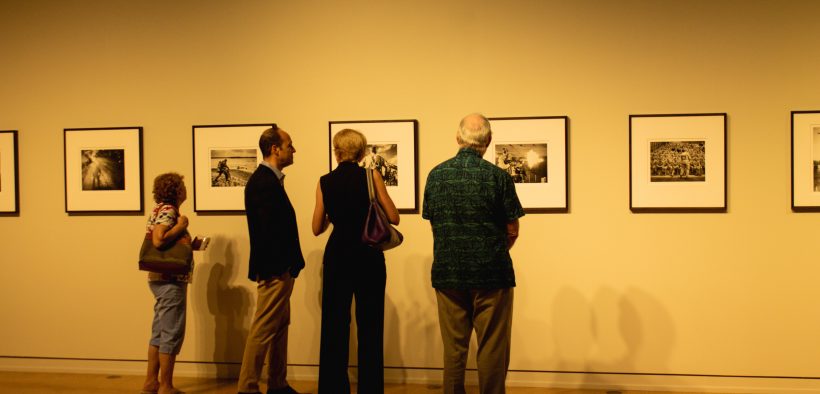Tom Morin: 25 Review
Share

Tom Morin’s photography exhibit, titled 25 for the twenty-five years it spans, is visiting the Sarofim Fine Arts Gallery until Nov. 12. On Fri., Oct. 18, Morin visited campus to present the exhibit to a group of art students at Southwestern. (Disclaimer: I am not a Studio Arts major, but I have experience in the art world and, not to mention, a fabulous editor who has guided me through the process of writing an art review.)
Having never attended an artist’s talk before, I came in with very few expectations. Because I also wrote an article introducing Tom Morin to the Southwestern community, I was already familiar with Tom Morin and his work. However, I waited to walk through the gallery until the day of the artist’s talk so I could have a fresh perspective of the exhibit. I shook hands with Morin as I arrived and proceeded to make my way around the gallery. On my first walk around, I stopped in front of each photograph and absorbed it without knowing its context. I had just enough time to peruse the gallery once more and take notes before Morin’s lecture began.
Morin shared the beginnings of his career as a photographer emphasizing that “what [students] do in college is relevant 20 years in the future.” Morin also analyzed the series which made up the exhibit: Metaphor, Remnants, and Service. For each series, Morin selected a few of his best and favorite photographs from 1992-2017. He discussed how each photo was made and his vision for each series. He also explained his process of selecting, arranging, and mounting the photos for the exhibition.
On Sat., Oct. 19, Morin returned to campus for a reception advertised to the public. A wide range of people showed for the reception, from Morin’s friends and family to Southwestern students and members of the Georgetown community. Tom Morin acknowledged some of his most dignified guests with gratitude. After a brief Q&A, hors d’oeuvres were served. I took the opportunity to revisit Morin’s photography and take some additional notes.
Morin’s Metaphor series (1992-2000) was my favorite of the three. As an English major, I’m a sucker for metaphors. I felt slightly discomforted by the images, but that was the beauty of them. The series was characterized by surrealism and deep contrast. In each photo, the light was cast on the subject, and the dark background was ready to swallow the subject whole. Morin’s photographs in Metaphor were crafted intentionally using the least amount of objects possible. Because of their vivid simplicity, the photos have a commercial quality. Additionally, the photos stand the test of time. Though they were shot in the 90’s, there are no clues to show which era they might belong to. The photos appear contemporary and could have easily been taken yesterday.
The Remnants series (2000-2008) was tangent to the Metaphor series in the gallery. Included were photographs of airplane light trails, chalkboards, and expended bullet shells. Before Morin went in depth about his works in the Remnants series, I had a hard time discerning what I was looking at. In a way, the images are more abstract than the Metaphor series since the subjects are taken out of context. Morin explained that in the Remnants series he was inspired to go out and find things to photograph instead of creating scenes as he did at the beginning of his career.
According to Morin, the photographs of the light trails were taken with no tripod and a “simple beat up camera”. When Morin produced these images in the dark room, he purposely allowed his thumbprints to resonate in the prints as if a form of signature. He explained the existence of his thumbprints at the corners of the photos is a “rebellion against the perfection” that professional photography is notorious for. The chalkboard photographs were also pleas against perfection. As a matter of fact, these photographs seem to be mounted on torn paper as if the photos themselves are rough around the edges. Morin claims the chalkboards can represent both the “transfer and erasure of knowledge.” Seeking closure, I searched for a hidden message in the partial equations that remained on the chalkboards. I managed not to find any. It appears Morin left the chalkboards untouched, contributing to the spontaneity of the photographs.
The Rounds grouping is also characterized by a chaotic, uncanny beauty. Unlike Airplanes and Chalkboards, the photos of bullet primer impressions were manufactured by the photographer. Morin painted a Nu Skin coating on the bullet shells and photographed the patterns under a microscope. While Morin’s process to photograph Rounds was more deliberate, the impressions left by the bullets were not a factor to be controlled, therefore making each image unique.
The transition into the Service series (2012-2017) from the Remnants series was well-conducted. Morin positioned the more abstract photos from this series closest to the Remnants series. The final photo of the series showed a familiar scene from Hurricane Harvey. In this photo series, Morin’s talent shines through in the Service series; many of the photos were taken in the spur of the moment. This series, unlike the others, documented events in raw, honest truth with the photographer as a bystander, not a facilitator. The documentation was especially impactful because it included facial expressions. Though these photos are all modern, Morin left them in black and white, likely to remove color as a distraction from the subject. Morin’s 25 resonates with me. He leaves his work open to interpretation and encourages the viewer to read between the lines of his work. My interpretations of his work are certainly not the only valid interpretations. I would encourage anyone who hasn’t yet visited the gallery to do so and form their own opinions of Metaphor, Remnants, and Service. The gallery will remain open Tues.-Sun. 12-5 p.m. until Tues., Nov. 12.
